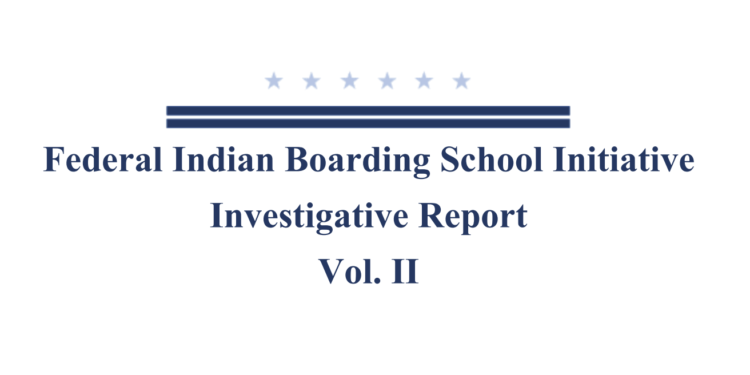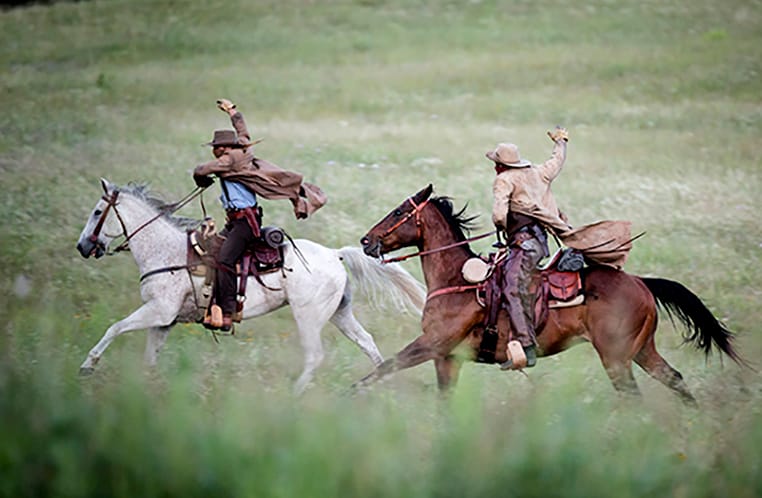

Federal Government acknowledges wrongdoing in Native boarding school policy, DOI report finds

by Thomas Jackson, Mvskoke Media
WASHINGTON D.C. – On July 30, United States Secretary of the Interior Deb Haaland announced the release of the final report by the Federal Indian Boarding School Initiative. The initiative was designed as “a comprehensive effort to recognize the troubled legacy of federal Indian boarding school policies with the goal of addressing their intergenerational impact and to shed light on the traumas of the past.” In other words, it was an effort by the U.S. government, which initially began in 2021, to investigate the actions taken by their predecessors against Native tribes. Three years later the final volume of their investigative report was released to the public.
According to the report, there were reportedly 417 different schools and institutions across 37 separate states and territories that were used for the purpose of the assimilation of Native children. Across these 417 locations, at least 973 Native children died while attending school. The report goes on to show the location of burial sites at around 65 different schools and explains how the U.S. government spent the modern equivalent of $23.3 billion on these Native boarding schools, similar locations and assimilation policies in between 1871 and 1969.
In a press release, the U.S. Department of the Interior explained that the investigation portion of its mission is over, now they will begin a path to healing and reconciliation. The steps for this path include the following, according to the press release:
“1. Issuing a formal acknowledgment and apology from the U.S. government regarding its role in adopting and implementing national federal Indian boarding school policies; 2. Investing in remedies to the present-day impacts of the federal Indian boarding school system; 3. The building of a national memorial to acknowledge and commemorate the experiences of Indian Tribes, individuals, and families affected by the federal Indian boarding school system; 4. Identification and repatriation of remains of children and funerary objects who never returned from federal Indian boarding schools; 5. Returning former federal Indian Boarding school sites to Tribes; 6. Telling the story of federal Indian boarding schools to the American people and global community; 7. Investing in further research regarding the present-day health and economic impacts of the federal Indian boarding school system; and 8. Advancing international relationships in other countries with similar but their own unique histories of boarding schools or other assimilationist policies.”
When asked for comment, Muscogee (Creek) Nation Principal Chief David Hill had this to say in a statement posted on Facebook. “Thankful for the work of the U.S. Department of the Interior and the Federal Indian Boarding School Initiative in finalizing and releasing this report. And relieved by the U.S. Government taking accountability for an era of forced assimilation, murder and erasure. Hopefully, we can use this as a mechanism of healing, and we can all together move forward stronger than ever. Our presence and survival today is living proof of our unbreakable spirit.”
The full report can be viewed on the official Bureau of Indian Affairs website, bia.gov.

New Wahzhazhe Health Center to open doors to existing patients in July 2025

The WZZHC will serve Osage and Native patients first, opening their doors for treatment by July of next year. Once their electronic health records are running in the new building on Main Street, the clinic will then receive non-Native ON employees and their families. By 2026, non-Natives who have insurance will be welcomed at the clinic.
Written by Chelsea T. Hicks, Osage News
The new Wahzhazhe Health Center is now visibly going up on Main Street in Pawhuska and its doors are slated to open to all existing Osage and Native American patients in less than one year.
According to current estimates from CEO Mark Rogers, the clinic will next treat non-Native ON employees and their families and spouses later in 2025, using the tribe’s insurance policy. Last of all, the clinic will open up to the general Pawhuska community by 2026.
The building itself is scheduled for completion by June 2025. Rogers noted the Wahzhazhe Health Center (WZZHC) does have approval to treat multiple forms of patients, but doing so “would blow the clinic out of the water,” said Rogers. Thus, the wait.
Rogers is calling the three-pronged service rollout a series of “spirals.” He explained, “the first spiral is fixing everything, which is currently being worked on”—and also serving existing patients from the WZZHC. “[The] second spiral is [the tribe’s] employees, families and spouses. Spiral three,” he explained, “will be the community at large.”
“All Osage patients [we currently] service and all Native American patients we now service will be seen June or July 2025” in the new building. “We will have to [move in,] hook [up] computers, printers, phones, assign offices … ready in numerous amounts of specialized medical and diagnostic equipment, move items into those offices, etcetera. … It is a tremendously huge logistical muscle movement,” he said, explaining why the health system cannot open to everyone at the same time.
WZZHC services
The new WZZHC will boast no less than 15 departments, including an emergency room.
Between October of 2025 and January of 2026, WZZHC will get a new electronic health records (EHR) system certified—the ultimate step allowing the clinic to operate at a scale that will allow them to service the entirety of the greater insured Pawhuska population.
Services will move “as-is” to the new clinic in July of next year. That means within one year, all existing Osage and Native American patients will be able to receive emergency care, primary and specialty care, pharmacy services, physical therapy, X-ray and lab services, dental, optometry, cardiology, neurology, endocrinology, nephrology, dermatology, orthopedics, podiatry, infectious disease, and behavioral health (including psychiatry and counseling) services—all in the capital of the Osage Nation.
Extended hours
While the WZZHC will at first open with “as-is” hours, it will ultimately be a seven-day-a-week facility open on holidays and weekends.
Rogers calls the extended hours “PlusCare,” and said patients will start to see the clinic open every day by October of 2025 at the earliest, or January of 2026 at the latest. The delay in expanded “PlusCare” hours at the opening of the new state-of-the-art medical facility is due to “staffing it up,” said the CEO, as well as ensuring that the new EHR system is operational.
Preparing for the opening
In the coming year, the WZZHC is focused on greasing its internal wheels.
Currently, the health system is still transitioning from the tribe to a standalone enterprise—and that means an ongoing focus on repairing, updating and improving revenue cycle management, space, operations and infrastructure.
Rogers is excited for the new clinic to be open to employees of the tribe and their families and dependents, he said, because servicing this group will help “[recuperate] the tribe’s investment in health insurance expenditures.”
Between now and 2026, the WZZHC will tackle three big transitions that will fully set them up to provide care to all who have health insurance. That is, they’ll undergo a process of getting new accreditation, finalize their new EHR system, which is crucial to billing and treating non-Native patients, and finally, they’ll get fully credentialed with multiple insurers.
The final stage of the new clinic’s operations—full, open access to services by the community, including Native and non-Native, seven days a week—will be quite a transformation from the look, feel and scale of the current WZZHC.
Those experiencing the new health center first will be its existing Osage and Native American patients.
If you are an enrolled Osage or Native American, and want to receive care at the WZZHC, call (918) 287-9300 and press 4 or visit 715 Grandview Avenue, Pawhuska, OK 74056 between 7 a.m. to 5:30 p.m. Monday through Friday. See more at https://s3.amazonaws.com/osagenation-nsn.gov/files/departments/WZZ-Health-Center/2022-1020-hours-operation-WHC%20%287%29.pdf
‘Montford: The Chickasaw Rancher’ screening set in Santa Fe

SANTA FE, N.M. – The Chickasaw Nation will have an enhanced presence at this year’s prestigious Santa Fe Indian Market as it seeks to educate film enthusiasts and recruit film and documentary talent.
Chickasaw Nation Productions (CNP) will present a special showing of “Montford: The Chickasaw Rancher” at no charge for thousands of art lovers expected to attend the market.
The Chickasaw Nation will staff a booth to attract talented actors for upcoming CNP projects and to explain the tribe’s film and documentary endeavors. It will be staffed by tribal officials Aug. 17-18.
“Montford: The Chickasaw Rancher” will be available to view at 5 p.m., Aug. 17, at the Violet Crown Cinema, within walking distance of the art market, according to Bridget Forshay, Chickasaw Nation marketing manager. CNP and Violet Crown Cinema are co-sponsoring the showing.
Forshay, along with Chickasaw Nation Marketing Director Shelly Miller and Senior Marketing Manager Travis Stanberry, will be on hand to visit with actors and interested patrons about registering with the Chickasaw Talent Database online at ChickasawFilms.Com.
The trio will answer questions and explain the successes enjoyed by the Chickasaw Nation in feature film production and documentaries.
Actors and film crew workers, both First Americans and non-First Americans, may register online for inclusion in the database, Miller said.
Chickasaw Nation Director of Creative Development Jeannie Barbour will be joined by Philip Sullivan, Chickasaw Nation Director of Video Production and Brad Clonch, Chickasaw Nation Executive Officer of Creative Services, 2 p.m. Aug. 17, at Santa Fe Plaza to talk about CNP, and its mission in films and documentaries.
CNP was established in 2009 as a result of Chickasaw Nation Governor Bill Anoatubby’s vision to utilize film production to preserve the stories of the Chickasaw people.
The goal of CNP is to educate audiences by producing feature films and documentaries with accurate, positive portrayals of Chickasaw people, history and culture.
Each film illustrates how Chickasaw culture played a significant role in the lives of the individuals and events portrayed in the films, and how those individuals and events influenced the world around them.
CNP has produced critically acclaimed full-length movies and documentaries. They include “Pearl,” “Te Ata” and “Montford: The Chickasaw Rancher.”
“Te Ata” and “Montford: The Chickasaw Rancher” were featured by Netflix during 2023’s National Native American Heritage Month and enjoyed extended airtime.
“Montford: The Chickasaw Rancher” remains available on Netflix.
“Te Ata” portrays the life of Mary Frances Thompson whose stage name was “Te Ata.” She entertained thousands of Chautauqua entertainment seekers as well as European royalty and President Franklin D. Roosevelt.
“Montford: The Chickasaw Rancher” follows the early life of famed rancher Montford Johnson, whose business, at its zenith, included more than 35,000 head of cattle roaming 1.3 million acres in Indian Territory.
“Pearl” tells the story of Chickasaw citizen Pearl Carter Scott. On Sept. 12, 1929, she became the youngest licensed pilot in the United States when she took her first solo flight at age 13. She studied flying with famed aviator and inventor Wiley Post.
CNP’s first documentary is also available on the website. “First Encounter” tells the story of the Chickasaw Nation’s encounter with Spanish conquistador Hernando de Soto in 1540.
For more information and to register for the Chickasaw Talent Database, visit ChickasawFilms.com.
Skydance Brewing Co. to partner with Sooner legend, Coach Barry Switzer to create a new beer brand for a great cause!

Oklahoma City, OK - Skydance Brewing Co. today announced a new partnership with Coach Barry Switzer to create “Switzer Light Lager.”
Switzer Lager is a light American lager brewed with football and tailgating in mind. The crisp and refreshing lager rings in at 4.8% ABV and will be sold in kegs and 6-packs of 12oz cans. A portion of the proceeds from the sales of Switzer Lager will go to, Ground Zero – Emergency K9 Training. A launch party is being planned for August 31st at Skydance Brewing Co. The beer will find it’s way onto shelves around Oklahoma the last week of August. Distribution of the beer will be done through Republic National Distributing Company. The can design was created by OKC based branding agency, Robot House.
“As a big Sooner fan, I’m extremely excited to partner with Coach Switzer on this project. Not only were we able to create the ideal beer for football season, but we’re also given this great opportunity to help Coach with Ground Zero,” said Skydance founder and CEO, Jake Keyes. “Sometimes during a football game or tailgating you want a light beer that just tastes like beer. That’s what we’ve done here.”
“Crafted with care by Skydance Brewing Co. in OKC, Switzer Light Lager is the perfect companion for this football season,” said former Sooner Football Coach Barry Switzer. “Every sip not only brings you the refreshing taste of a premium light lager, but also supports a noble cause. Proceeds from Switzer Light Lager sales will benefit Ground Zero, our dedicated non-profit search, rescue and recovery canine training facility. Enjoy great beer and make a difference! Look for Switzer Light Lager at retail outlets throughout Oklahoma. Cheers to good beer and a great cause!”
About Skydance Brewing Co.
Skydance Brewing Co. is Oklahoma’s Native American craft brewery. Founded in 2018, Skydance began brewing beer in a co-op brewery, The Brewers Union, before opening a location of their own in Automobile Alley at 1 NE 7th St. in Oklahoma City, OK. Skydance has a 2,000 sq ft taproom with a large patio at its current location.
With a 15 bbl brewhouse and packaging line, Skydance produces beer that is distributed to retail locations all over Oklahoma. Since opening, Skydance has garnered recognition from multiple publications, including being named as one of the 12 Best New Breweries of 2021 by Hop Culture Magazine and its founder, Jake Keyes, was named to 405 Business Magazines list of the Metro’s Most Influential. Skydance is particularly known for brewing great IPA’s and for collaborating with Native American artists to create beautiful artwork for their cans.
Founder, Jake Keyes, was recently elected to his first term as Chairman of the Iowa Tribe of Oklahoma.
About Ground Zero
Ground Zero Emergency Training Center is a Non-Profit Organization in Oklahoma. They specialize in enhancing America’s emergency response capabilities to natural and man-made disasters by providing local, state and federal First Responders with exceptionally trained urban search and rescue canines, educational opportunities, and a state-of-the-industry facility in which to hone their technical skills. Ground Zero was founded by Oklahomans, Barry & Becky Switzer in 2017 to meet the needs of a critical shortage in search-and-rescue canines.
The catalyst for Ground Zero began on April 19, 1995, following the bombing of the Alfred P. Murrah Federal Building in Oklahoma City. As one of the top three disaster states, Oklahoma was vulnerable in its ability to prepare and respond adequately to natural and man-made disasters. The Switzers discovered the reason for the shortage of elite working canines in our country was due to a lack of trainers and training areas available. In addition, the cost to train and care for the canines far exceeded the already strained state department budget.
Over the next several years, multiple tragedies would occur in Oklahoma, including the devastating tornadoes of May 1999 and 2013. When the 9/11 terrorist attacks stunned the nation, the Switzers knew something had to be done to strengthen emergency response at the local, state & national level.
Since 2017, Ground Zero has evolved from a personal passion and dream to a thriving nonprofit organization garnering local, statewide and national attention along with 29 successful canine and handler pairings.




